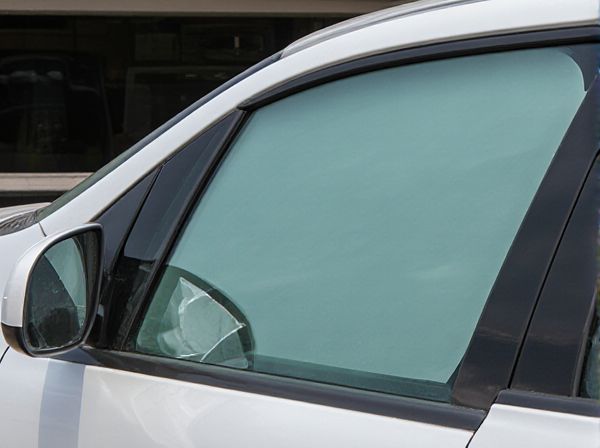
Photo illustration: Laminated vs Tempered Glass
Laminated glass consists of two or more layers of glass bonded with an interlayer, providing enhanced safety by holding shards together when broken. Tempered glass is heat-treated to increase strength and shatter into small, blunt pieces, reducing injury risk. For maximum protection, consider your specific needs when choosing between laminated or tempered glass for your project.
Table of Comparison
| Feature | Laminated Glass | Tempered Glass |
|---|---|---|
| Composition | Two glass layers with a plastic interlayer | Single glass layer heat-treated for strength |
| Safety | Holds together when shattered, reduces injury risk | Shatters into small blunt pieces |
| Sound Insulation | Excellent noise reduction | Moderate noise reduction |
| UV Protection | Blocks up to 99% UV rays | Limited UV protection |
| Durability | High resistance to penetration and impacts | High strength but more prone to breakage on edge hits |
| Use in Cars | Primarily used for windshields | Commonly used for side and rear windows |
Introduction to Laminated and Tempered Glass
Laminated glass consists of two or more layers of glass bonded together with an interlayer, providing enhanced safety and sound insulation by holding the shards in place upon breakage. Tempered glass undergoes a heat treatment process that increases its strength and causes it to shatter into small, blunt pieces instead of sharp shards. Both types are widely used in automotive, architectural, and safety applications due to their unique protective properties.
What is Laminated Glass?
Laminated glass consists of two or more glass layers bonded with an interlayer, typically polyvinyl butyral (PVB), enhancing safety by holding shards together upon impact. It offers superior sound insulation and UV protection compared to tempered glass. Commonly used in automotive windshields and architectural applications, laminated glass provides durability and security while maintaining transparency.
What is Tempered Glass?
Tempered glass is a type of safety glass processed by controlled thermal or chemical treatments to increase its strength compared to normal glass. When broken, it shatters into small, blunt pieces that reduce injury risk, making it ideal for automotive windows, shower doors, and building facades. Its high resistance to impact and thermal stress distinguishes tempered glass from laminated glass, which holds shards together with an interlayer.
Key Differences Between Laminated and Tempered Glass
Laminated glass consists of two or more layers of glass bonded with an interlayer, providing enhanced safety by holding shards together upon impact, while tempered glass undergoes heat treatment to increase strength and shatters into small, blunt pieces for reduced injury risk. Laminated glass is favored for sound insulation and UV protection, commonly used in car windshields and skylights, whereas tempered glass offers higher resistance to thermal stress and is widely applied in doors, windows, and shower enclosures. The primary difference lies in laminated glass's impact retention and multi-layer structure versus tempered glass's strength from tempering and fragmenting safety mechanism.
Strength and Durability Comparison
Tempered glass offers superior strength with a tensile strength approximately four to five times greater than laminated glass, making it highly resistant to impact and thermal stress. Laminated glass, composed of two or more glass layers bonded with an interlayer, provides enhanced durability by preventing shattering and maintaining structural integrity upon impact. The interlayer in laminated glass improves safety by holding fragments together, whereas tempered glass breaks into small, blunt pieces, reducing injury risk but lacking the same post-impact cohesion.
Safety Features: Laminated vs Tempered Glass
Laminated glass consists of two or more layers of glass bonded with an interlayer, which holds shards together upon impact, reducing the risk of injury and providing enhanced security against forced entry. Tempered glass undergoes a heat treatment process that makes it stronger and causes it to shatter into small, blunt pieces, minimizing the chance of severe cuts. Both types offer distinct safety advantages: laminated glass excels in preventing penetration and holding glass fragments in place, while tempered glass provides superior strength and safer breakage patterns in high-impact situations.
Applications and Common Uses
Laminated glass is widely utilized in automotive windshields, skylights, and storefronts due to its enhanced safety features and ability to hold shards together upon impact. Tempered glass is commonly found in side and rear automotive windows, shower doors, and architectural facades where increased strength and shatter resistance are essential. Both types serve critical roles in transportation, construction, and interior design, optimizing safety and durability based on specific application requirements.
Cost Analysis: Laminated vs Tempered Glass
Laminated glass typically costs 20-30% more than tempered glass due to its additional layers and interlayer materials that enhance safety and sound insulation. Tempered glass offers a more cost-effective solution, priced between $12 to $25 per square foot, while laminated glass ranges from $20 to $45 per square foot depending on thickness and brand. Long-term expenses also favor laminated glass because it maintains integrity after impact, reducing replacement frequency compared to the more fragile tempered glass.
Energy Efficiency and UV Protection
Tempered glass offers enhanced energy efficiency by providing better insulation and heat resistance, reducing overall energy consumption for heating and cooling systems. Laminated glass excels in UV protection, blocking up to 99% of harmful ultraviolet rays, which helps prevent interior fading and protects occupants from UV exposure. Combining both laminated and tempered glass technologies optimizes energy savings while ensuring superior UV defense for residential and commercial buildings.
Which Glass Type Should You Choose?
Choosing between laminated and tempered glass depends on your safety, durability, and design needs. Laminated glass offers enhanced security and sound insulation by holding fragments together when shattered, making it ideal for windows in high-risk areas or sound-sensitive environments. Tempered glass provides superior strength and thermal resistance, breaking into small, less harmful pieces, which suits applications requiring impact resistance and safety, such as vehicle windows and shower doors.
 caratoz.com
caratoz.com